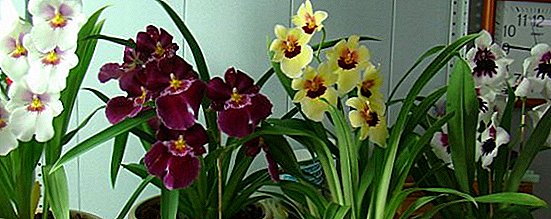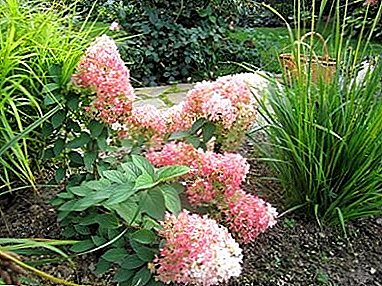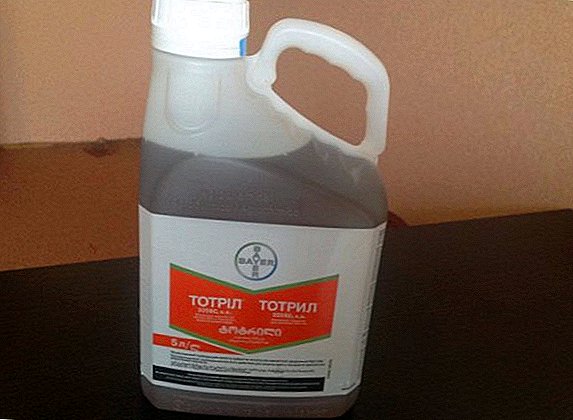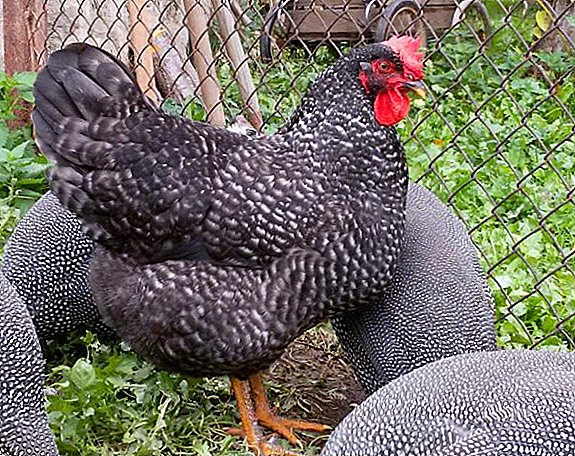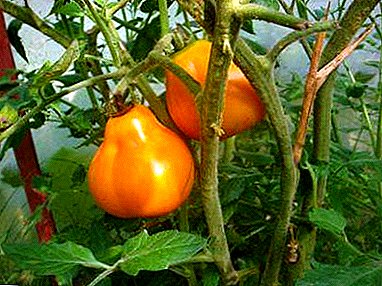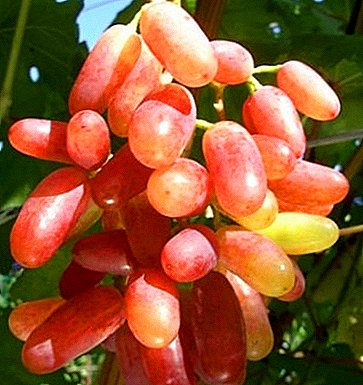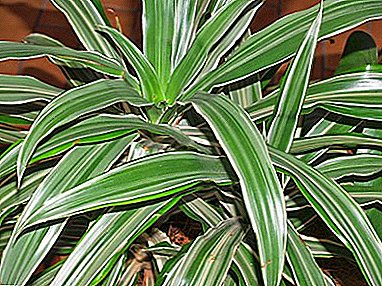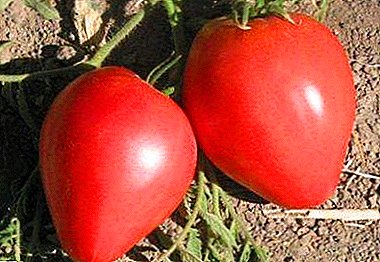
Eagle Beak is an interesting and unusual variety of tomatoes. It has a high yield, not too picky about care.
On high and powerful bushes juicy and sweet fruits of beautiful beak-shaped form ripen, which are good both in salads and in salting.
A detailed description of this variety can be found in our article. We will also introduce you to its characteristics, cultivation features and other important points.
Tomato "Eagle beak": description of the variety
| Grade name | Eagle's beak |
| general description | Mid-season semi-determinant variety |
| Originator | Russia |
| Ripening | 100-110 days |
| The form | Beak-shaped with pointed and slightly curved tip |
| Colour | Red |
| Average tomato mass | 200-800 grams |
| Application | Universal |
| Yield varieties | up to 8 kg from a bush |
| Features of growing | Agrotechnika standard |
| Disease resistance | Disease resistant |
 The grade of the Russian selection intended for cultivation in an open ground, film hotbeds and greenhouses. Harvested fruits are well stored and transported.
The grade of the Russian selection intended for cultivation in an open ground, film hotbeds and greenhouses. Harvested fruits are well stored and transported.
Eagle's beak is a variety of large-ripened middle-ripe tomatoes. The bush is semi-determinant, 1.2-1.5 m high. For successful development and good fruiting, forming and tying are required. Very good yield, you can collect up to 8 kg of tomatoes from one bush.
| Grade name | Yield |
| Eagle's beak | up to 8 kg from a bush |
| Bobcat | 4-6 kg from a bush |
| Rocket | 6.5 kg per square meter |
| Russian size | 7-8 kg per square meter |
| Prime minister | 6-9 kg per square meter |
| King of Kings | 5 kg from a bush |
| Stolypin | 8-9 kg per square meter |
| Long keeper | 4-6 kg from a bush |
| Black bunch | 6 kg from a bush |
| Grandma's Gift | 6 kg per square meter |
| Buyan | 9 kg from a bush |
 Read also on our website: How to grow tasty tomatoes all year round in winter greenhouses? How to get a great harvest in the open field?
Read also on our website: How to grow tasty tomatoes all year round in winter greenhouses? How to get a great harvest in the open field?What varieties of tomatoes are disease resistant and high yielding? How to care for early varieties?
Specifications
Among the main advantages of the variety:
- excellent yield;
- high taste of fruits;
- beautiful fruits of unusual shape;
- resistance to major diseases.
The disadvantages are minor. Bushes are not too high, but powerful and sprawling, they need to be tied up and stitchling. The plant is demanding on the nutritional value of the soil, likes abundant watering and frequent feeding.
Characteristics of tomato "Eagle beak":
- Fruits are large, even, the weight of individual copies reaches 800 g.
- In the first phase of fruiting tomatoes are larger, the subsequent smaller, 200-400 g.
- The unusual coracoid shape with a pointed and slightly curved tip deserves attention.
- The flesh is juicy, dense, low seed.
- Taste is saturated, sweetish.
- The dense glossy peel protects fruits from cracking.
To compare the weight of fruits with other varieties:
| Grade name | Fruit weight |
| Eagle's beak | 200-800 grams |
| Peter the First | 30-250 grams |
| Crystal | 30-140 grams |
| Pink flamingo | 150-450 grams |
| The baron | 150-200 grams |
| Tsar Peter | 130 grams |
| Tanya | 150-170 grams |
| Alpatieva 905A | 60 grams |
| Lyalafa | 130-160 grams |
| Demidov | 80-120 grams |
| Dimensionless | up to 1000 grams |
The variety is universal, tomatoes are suitable for fresh consumption, preparation of salads, hot dishes, soups, juices. Unusual fruits are good for canning., salted or pickled tomatoes look very nice in banks.
A photo
We invite you to familiarize yourself with the Eagle Beak variety tomatoes on the following photo materials:




Features of growing
 Seeds are sown on seedlings in March or early April. Tomatoes need a light fertile soil consisting of a mixture of garden soil and humus.
Seeds are sown on seedlings in March or early April. Tomatoes need a light fertile soil consisting of a mixture of garden soil and humus.
Read more about the soil for seedlings and for adult plants in greenhouses. We will tell you about what types of soil for tomatoes exist, how to prepare the right soil on your own and how to prepare the soil in the greenhouse in spring for planting.
For greater nutritional value, superphosphate or wood ash is added to the mixture. Seeds are soaked for 10-12 hours in a growth stimulator.. Sowing with a depth of 2 cm, the container is closed with a film and placed in heat. After the appearance of germs capacity expose to the bright light.
In the formation phase of 2 true leaves, the seedlings swoop into separate pots. Watering is moderate, only with warm settled water. Immediately after the picking, fertilizing with a liquid complex fertilizer is recommended. Another feeding is carried out before moving the seedlings to a permanent place.
Planting under a film or a greenhouse is possible in the first half of May; plants are planted in the open ground closer to the beginning of June. The soil should be completely warm. Before planting, the soil is loosened, phosphorus and potash fertilizers are laid out in each well (no more than 1 tbsp. Spoons). Landings are not thickened by 1 square. m place no more than 3 plants.
Watering plentiful, but not frequent (1 time in 6-7 days). In season, plants need to feed 3-4 times. It is recommended to alternate between organic matter and complex mineral fertilizers with a predominance of potassium and phosphorus. After the start of flowering, nitrogenous supplements are canceled, they can slow down the formation of ovaries. Shrubs form in 1 or 2 stems, removing stepchildren and lower leaves.
Pests and diseases
 The variety is resistant to the main diseases: late blight, fusarium, tobacco mosaic.
The variety is resistant to the main diseases: late blight, fusarium, tobacco mosaic.
To fully secure the landing, you need to take preventive measures. The ground for seedlings is ignited in the oven; before planting in the greenhouse, the ground is spilled with a hot solution of potassium permanganate.
For the prevention of fungal diseases, saplings are regularly sprayed with phytosporin or other non-toxic bio-preparations. Will help and pale pink solution of potassium permanganate. With the threat of late blight, plantings are sprayed with copper-containing preparations.
Against insect pests, you can use industrial insecticides or proven folk remedies: soapy water, a solution of potassium permanganate and ammonia, a decoction of onion peel, chamomile, celandine. Frequent airing of greenhouses and weeding is recommended.
By planting several Eagle Beak bushes in a greenhouse, greenhouse, or open field, gardeners can count on an excellent harvest. If desired, the seeds for the next crop can be collected independently.
| Early maturing | Middle late | Medium early |
| Garden Pearl | gold fish | Um Champion |
| Hurricane | Raspberry wonder | Sultan |
| Red Red | Miracle of the market | Dream lazy |
| Volgograd Pink | De barao black | New Transnistria |
| Helena | De Barao Orange | Giant Red |
| May Rose | De Barao Red | Russian soul |
| Super prize | Honey salute | Pullet |


